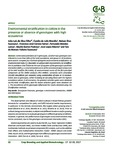Por favor, use este identificador para citar o enlazar este ítem:
http://www.alice.cnptia.embrapa.br/alice/handle/doc/1065996Registro completo de metadatos
| Campo DC | Valor | Lengua/Idioma |
|---|---|---|
| dc.contributor.author | SILVA FILHO, J. L. da | pt_BR |
| dc.contributor.author | MORELLO, C. de L. | pt_BR |
| dc.contributor.author | SUASSUNA, N. D. | pt_BR |
| dc.contributor.author | FARIAS, F. J. C. | pt_BR |
| dc.contributor.author | LAMAS, F. M. | pt_BR |
| dc.contributor.author | PEDROSA, M. B. | pt_BR |
| dc.contributor.author | RIBEIRO, J. L. | pt_BR |
| dc.contributor.author | SUASSUNA, T. de M. F. | pt_BR |
| dc.date.accessioned | 2017-03-03T11:11:11Z | pt_BR |
| dc.date.available | 2017-03-03T11:11:11Z | pt_BR |
| dc.date.created | 2017-03-03 | pt_BR |
| dc.date.issued | 2017 | pt_BR |
| dc.identifier.citation | Crop Breeding and Applied Biotechnology, v. 17, p. 32-39, 2017. | pt_BR |
| dc.identifier.uri | http://www.alice.cnptia.embrapa.br/alice/handle/doc/1065996 | pt_BR |
| dc.description | Cottonseed yield data of 17 genotypes, of which two genotypes contributed to more than 30% of the total ecovalence, and grown in 23 locations, were used to compare four methods of disjoint environmental stratification: a) environmental index (Ie): favorable or unfavorable environments; b) stratification in partitions that maximize the sum of squares of the genotype x partition interaction [(GP)m]; c) environmental scores of the second principal component of the GGE analysis (PC2-GGE); d) environmental scores of the first principal component of the AMMI analysis (PC1-AMMI). Scenarios were simulated (10,000 simulations per scenario) using combination of nine or 13 environments and 11 genotypes, either including or excluding those with the highest ecovalence values. In all scenarios, the greatest selection gains were obtained via PC2-GGE stratification, and the lowest selection gains were obtained via Ie. The ecovalences of the genotypes influenced the results obtained using the stratification methods. | pt_BR |
| dc.language.iso | eng | eng |
| dc.rights | openAccess | eng |
| dc.title | Environmental stratification in cotton in the presence or absence of genotypes with high ecovalence. | pt_BR |
| dc.type | Artigo de periódico | pt_BR |
| dc.date.updated | 2018-01-16T11:11:11Z | pt_BR |
| dc.subject.thesagro | Gossypium hirsutum | pt_BR |
| dc.subject.thesagro | Algodão | pt_BR |
| dc.subject.thesagro | Genótipo | pt_BR |
| dc.subject.nalthesaurus | Cotton | pt_BR |
| dc.subject.nalthesaurus | Cottonseed | pt_BR |
| riaa.ainfo.id | 1065996 | pt_BR |
| riaa.ainfo.lastupdate | 2018-01-16 -02:00:00 | pt_BR |
| dc.identifier.doi | 10.1590/1984- 70332017v17n1a5 | pt_BR |
| dc.contributor.institution | JOAO LUIS DA SILVA FILHO, CNPA; CAMILO DE LELIS MORELLO, CNPA; NELSON DIAS SUASSUNA, CNPA; FRANCISCO JOSE CORREIA FARIAS, CNPA; FERNANDO MENDES LAMAS, CPAO; MURILO BARROS PEDROSA, FUNDAÇÃO BAHIA; JOSE LOPES RIBEIRO, CPAMN; TAIS DE MORAES FALLEIRO SUASSUNA, CNPA. | pt_BR |
| Aparece en las colecciones: | Artigo em periódico indexado (CNPA)  | |
Ficheros en este ítem:
| Fichero | Descripción | Tamaño | Formato | |
|---|---|---|---|---|
| Environmentalstratificationincotton.pdf | 298,12 kB | Adobe PDF |  Visualizar/Abrir |









